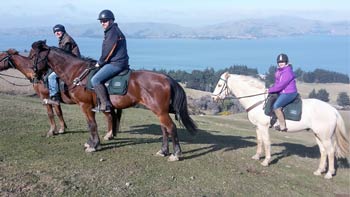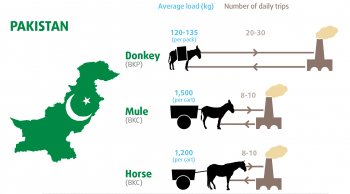17 Jul 2017
Alex Draper asks how much weight is too much for horses to carry – and how you raise the sensitive topic with larger owners.

Figure 1. Riding horses in New Zealand. Are we too big?
Having embarked on a trip to New Zealand last year, I was keen to ride a horse along the beach in Dunedin. This would then have totalled my horse riding exploits to include almost every continent (I am still missing South America and Antarctica).
My riding companion on this trip was a rather reluctant Scottish fellow, who I was worried may have been above the trekking centre’s weight limit, given a recent poodle around Hyde Park where the riding school’s weight limit was 12st (76kg). Thus, I was very pleased (him not so) their limit was 100kg (15st 10lb), as they had “some very big hunters”.

On arrival at said trekking centre, we both rode horses that were 16 hands high (hh) and had a rough body condition score of two to three out of five (Figure 1). Not exactly “big hunter” types. All we did was wander up a very steep hill and down again; however, this got me thinking – what should be the weight limit for riding horses?
Plus, as a vet, how would I approach a situation with an owner who was too big to ride his or her horse – or worse, his or her size was causing orthopaedic problems or a pain response in a horse? In short, how big is too big?
Intuitively, when I tried to answer this first question, it seemed to depend on many different factors:
We can all easily imagine a 16hh Irish draught horse can carry a lot more weight than a 16hh slight thoroughbred, even though their height is the same. As a general guideline in the UK, a rider should weigh no more than 10% of the horse’s bodyweight, but in the US, this limit is doubled to 20% of the horse’s weight.
This means for a 500kg horse, the range for the maximum rider weight is large – 50kg in the UK (just less than 8st) and 100kg in the US (15st 10lb). These anecdotal “rules” are quoted ubiquitously, but I could not find any concrete research confirming or refuting these. Worrying.
In addition, the weight limit of the rider will depend on the discipline being undertaken, and to what level that discipline is performed; professional sportspeople and horses will be much fitter than the average rider/horse. The fitter a person is, the better balanced he or she should be, meaning the horse should have to expend less energy.
For many equestrian sports, no weight limits exist, and if they do a maximum limit is given. However, under Fédération Equestre Internationale rules, endurance riders have to weigh a minimum of 75kg1. This may have its roots in eventing and showjumping, whereby horse and tack had to weigh greater than 75kg, as this was deemed to be the average weight of a cavalry soldier2.
Endurance horses typically weigh between 380kg to 420kg and, thus, routinely race more than 100km, carrying a minimum of 17.8% to 19.7% of their bodyweight, but there doesn’t seem to be a good rationale for this and, to me, it makes more sense to introduce a maximum weight limit.
The Government doesn’t appear to provide any guidelines under the riding establishment licence scheme3, but a quick trawl through some riding school websites and they seem to have a limit of 76kg to 101kg (12st to 16st). Is this a large oversight by the Government?
In contrast, working donkeys on UK beaches have been limited to carrying no more than 50.8kg (8st) since 2008. This limit was introduced according to guidelines from The Donkey Sanctuary4. Given donkeys are usually no more than 180kg, this means they could be asked to carry 28% or more of their bodyweight. You do need to keep in mind, however, that these donkeys are only doing short rides and at a very slow speed.
Working equids in developing countries can be forced to carry as much as 75% of their bodyweight in one load, contributing to multiple trips per day (for example, bricks or produce; Figure 2). These conditions are constantly being improved by charities such as Brooke5, through education and providing veterinary care to these equids.
As you can see, there seems to be an array of different rider weight limits applied to horses in differing situations, reflecting the problem that “one size doesn’t fit all” in this particular topic.

A study of 366 endurance horses6 concluded the body condition score of the horse was more important as a factor to it finishing a race than its rider/tack weight. This study commented that “well-conditioned” horses should be able to carry 20% to 30% of their bodyweight for 100 miles.
In contrast, a study looking at unfit “lesson horses” found as the rider’s weight reached 30% of the horse‘s, the horse had a significantly higher work rate at trot and canter compared to weights of less than 25%.
This is not surprising, but, more worryingly, horses had significantly higher creatine kinase (CK) and aspartate aminotransferase (AST) levels after exercising with 30% rider bodyweight7. Horse conformation is an important contributor to its weight-carrying abilities – specifically, bone density and loin width appear important8. Repeated overloading of metacarpal III in endurance horses has been shown to “increase incidence of biomechanical failure“9. One study found horses ideally had a mid-cannon bone circumference of 20cm per 454.4kg bodyweight, otherwise they risked increased orthopaedic injuries9.
Stefansdottir et al (2017)10 found Icelandic ponies with a greater back body condition score (that is, more muscled/fat-covered back) could withstand a greater rider weight (up to 30% of their bodyweight) before their lactate reached a steady state, and no evidence of muscle damage was apparent (CK and AST levels) in any ponies, regardless of the weight of rider they carried.
The same authors also evaluated the kinematics of the Icelandic ponies’ gait during the same exercise study11 and found their stance phase increased with increasing rider weight, with the increasing stance phase occurring during the bipedal support (tölt involves two stance phases – one unipedal and one bipedal). This would be of importance should the steed have any ongoing orthopaedic problems – especially arthritis or laminitis.
It is hopefully obvious to equine vets why repeatedly overloading a horse is not appropriate and is a welfare consideration, but I wonder if it occurs to owners? Glancing through the forum pages of many equine sites, it seems rider weight is a “hot topic” – especially among people who work at riding schools. This is encouraging to see.
Speaking personally, I have never been confronted with a situation where I have felt an owner is simply too large for his or her equine companion. So, I asked other equine veterinary colleagues if they have and, if so, how have they dealt with it, and whether it had it led to any clients being lost. Most vets had encountered this problem and felt they needed to address it with their clients – often by using the phrase “your horse is too small really for what you want it to do”. This is definitely preferable to “you are simply too fat”.
Interestingly, the majority of vets felt owners responded in a positive manner to these discussions, and they quite often occurred where horses were not skeletally mature enough for the work they were being expected to do. One vet said they had not felt confident enough to approach this topic with a mother who was riding her child’s section A on a regular basis, leading to back problems, but gained support from a more experienced colleague, who was able to help them address the situation with the client.
As vets, we are here to place the welfare of the horse as our highest priority. However, sometimes this is a delicate balance between keeping our clients happy. After looking further into the topic of riders’ weights, the situation is compounded by the horse’s conformation and the discipline to be performed, rider size and ability, and probably the age of the horse as well, but an absolute upper rider weight limit of 30% of the horse’s bodyweight seems sensible. As with everything in equine veterinary medicine, client education and communication is key, so I feel I can now approach this topic with a client in the future if the situation arises.